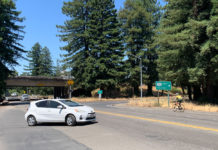Proposed summit hoped to offer alternative to new pond
construction
By PETE MORTENSEN, News Editor
An increasing need for wastewater capacity has Windsor stuck
between a rock and a hard place. With its permit with the Regional
Water Control Board set to expire in January 2007, the Town’s staff
is working to find short- and long-term answers to its needs, but
no palatable answer is at hand.
For its permit, the Town must demonstrate its efforts to improve
its wastewater systems. As Public Works Director Richard Burtt
explained to the Town Council at its March 15 meeting, Windsor has
not constructed a significant storage facility since 1990, when
they built the 80-million gallon Pond 7, located in the Corporation
Yard on Windsor Road. A lack of storage has limited the Town’s
ability to offer reclaimed water for irrigation, though the Vintana
neighborhood is exclusively served in that fashion.
Plans to connect Windsor to the Geysers Pipeline for additional
discharge of 750,000 gallons of treated wastewater per day and
construct Pond Z have not come to fruition. The Geysers project
would have reduced the Town’s need for wastewater storage by 140
million gallons, postponing further storage needs for 15 years.
Santa Rosa’s needs for greater discharge has led to expanded use of
the Geysers pipeline, making it completely uncertain whether
Windsor will ever connect to it, a staff report on the subject
notes.
All of this has forced the Town to explore two sites for
possible wastewater storage expansion – Ponds S and T, located
southwest of Windsor off of Eastside Road. The facilities would
require the construction of dams as tall as 125 feet. Burtt asked
the Council to fund preliminary engineering, costing between
$600,000-$700,000 on development of one of the ponds. A single pond
could offer between 125 to 249 million gallons of storage capacity,
which would serve the Town’s needs for an additional 15-30 years.
The total costs of the projects are between $6.5-12 million. Only
the most expensive and largest configuration, Pond T1, offers
significant storage capacity above and beyond the amount of water
that could be accommodated if a Geysers Pipeline connection were
completed. Burtt said Windsor’s processing plant takes in about 2
million gallons of wastewater per day during non-rainy periods and
up to 7 million gallons per day during heavy rain.
Burtt also requested considering the relocation of the Town’s
discharge point from Mark West Creek to the Russian River, which
could eliminate the need for the new facilities. But it also might
not be allowed under the new California toxics law, he said.
“And it may take as long to construct as the ponds
would,” Burtt said. He estimated either project would take about
five years to complete, and a year of preliminary engineering.
This does not mean a less-challenging solution isn’t available
to the Town, but it hasn’t appeared yet. In addition to the Geysers
Pipeline, the Town has negotiated with Santa Rosa Junior College
about a reclamation pond at Shone Farm, with adjacent vineyard
owners, joint use of the Airport area wastewater facility with the
Sonoma County Water Agency and even the Windsor’s own Pond Z site,
which had to be abandoned in 2002 due to seismic instability.
“We have so far had five years of discussion, and we
haven’t gotten anything,” Burtt said. “We hope at the end
of 10-12 months, we have something and can move forward with either
project or at least some alternative short-term storage.”
When setting its priorities for reclaimed water in a 2001 master
plan, Town leaders put reuse within the Town limits and sphere of
influence at the top, followed by outside agricultural reuse, reuse
at the Geysers and discharge into Mark West Creek. The first two
priorities have been expanded but don’t meet the present demand.
The Town’s water reclamation treatment plan was improved to allow
an average dry weather flow treatment capacity of 2.25 million
gallons per day, a 50 percent increase. The challenge lies in
disposal.
Councilmember Debora Fudge said the serious difficulties Windsor
is facing highlights county-wide problems with water and wastewater
that are being tackled piecemeal.
“I’m really frustrated,” she said. “All the
agencies are going out to do their own thing with wastewater, and
we go to negotiation with them and don’t get anywhere. Š I
understand we’re under a gun and we need to show to the Regional
Water Board that we’re going ahead and adding to our systems so we
don’t get into trouble like other cities have, but I’m not
comfortable spending $600,000 to $700,000 to look at these
ponds.”
As Fudge pointed out, the properties presently have hundreds of
protected trees on them that would need to be mitigated in the
process, sending the costs even higher.
“There will be 90 to 100-foot dams there,” she said.
“It’s huge. This undertaking is huge and scary, and we
talked about this during the water master plan we did five or six
years ago, and said that’s the last choice. In all of our
priorities, it was priority number five.”
Fudge proposed trying once more to bring all affected parties to
the table and try to negotiate a bigger picture answer to the
wastewater needs of the county as a whole.
“When people find out the extent of what we’re going to
have to do for wastewater, there are going to be concerns, and even
other cities may be concerned that we’re building dams,” she said.
“It’s so frustrating, and if we do one more step before we
invest money, I would feel better.”
Councilmember Steve Allen also expressed serious reservations
about accepting Ponds S and T as solutions to Windsor’s wastewater
needs.
“What if we get out there, do the geotechnical work and
say, ‘Gosh, it doesn’t look like this going to work from a seismic
standpoint,’” he said. “I would hate to go down that road,
get down to that point and be up the creek, so to speak.”
Allen suggested funding a request-for-proposal for the
preliminary engineering. Such an RFP document will likely take
about two months to prepare, Burtt said, at a cost of about
$25,000. If the Council can hammer out a new agreement in that time
frame, the money committed to such a project would be much
less.
Windsor’s growth has put the Town in the position it currently
faces, Councilmember Lynn Morehouse said.
“It seems like our day of reckoning is here,” she said.
“This is the consequence of the rate of growth that we’ve
put forth. Š Pond T or Pond S is a decision none of us want to
make. My thought would be to try coordination with the other
agencies, but I think we need to look at both development of Pond S
or Pond T and whether we’re going to change our discharge point (to
the Russian River).”
Mayor Sam Salmon said it might be a good idea to get other
agencies involved but expressed worry that such a meeting would
accomplish anything.
“The only way you get people in a room is to put out a
big bag of money,” he said.
Even asking for such help puts Windsor in an unfamiliar place,
Fudge said.
“We’ve been sitting pretty the whole time I’ve been
here because of all the work done prior to my coming here, and
we’re always been in better shape than most other people,” she
said. “It really bothers me that we’re now up against the
same problems they are, and we’re not all working together.”
The lead Windsor enjoyed for years has “slipped” in the
last five years, Town Manager Matt Mullan said.
“We’re backed into a corner because we haven’t been
able to do phased expansion,” he said.
The Town Council voted unanimously to move forward with the RFP
document while also attempting to set up what was dubbed a
“wastewater summit.” Fudge noted the Town had $4.5 million
to spend on a wastewater treatment project. Morehouse said the
end-result of the continued development of the county might be to
make water the most precious resource.
“Water is potentially going to become the new cash
crop,” she said, suggesting vintners might take a crop location
permanently out of rotation if they could make money off a
wastewater pond at the site.
“That would be interesting, going from wine to
water.”
Reached Monday, Mullan said such a summit has not yet been
scheduled, but involved staff-members will start planning the event
this week.
“We’re obviously going to follow the direction of the
Council,” he said, “but we need to strategize how we’re
going to do that and how quickly we’re going to do that.”
95.8
F
Healdsburg
July 10, 2025








